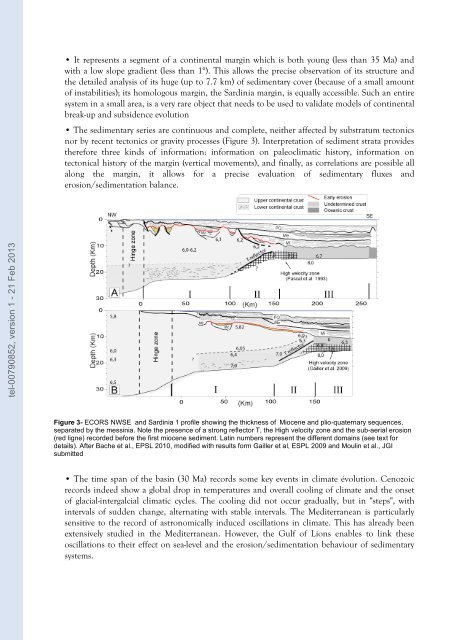Quantification des flux sédimentaires et de la subsidence du bassin ...
Quantification des flux sédimentaires et de la subsidence du bassin ...
Quantification des flux sédimentaires et de la subsidence du bassin ...
Create successful ePaper yourself
Turn your PDF publications into a flip-book with our unique Google optimized e-Paper software.
tel-00790852, version 1 - 21 Feb 2013<br />
• It represents a segment of a continental margin which is both young (less than 35 Ma) and<br />
with a low slope gradient (less than 1°). This allows the precise observation of its structure and<br />
the d<strong>et</strong>ailed analysis of its huge (up to 7.7 km) of sedimentary cover (because of a small amount<br />
of instabilities); its homologous margin, the Sardinia margin, is equally accessible. Such an entire<br />
system in a small area, is a very rare object that needs to be used to validate mo<strong>de</strong>ls of continental<br />
break-up and subsi<strong>de</strong>nce evolution<br />
• The sedimentary series are continuous and compl<strong>et</strong>e, neither affected by substratum tectonics<br />
nor by recent tectonics or gravity processes (Figure 3). Interpr<strong>et</strong>ation of sediment strata provi<strong><strong>de</strong>s</strong><br />
therefore three kinds of information: information on paleoclimatic history, information on<br />
tectonical history of the margin (vertical movements), and finally, as corre<strong>la</strong>tions are possible all<br />
along the margin, it allows for a precise evaluation of sedimentary <strong>flux</strong>es and<br />
erosion/sedimentation ba<strong>la</strong>nce.<br />
Figure 3- ECORS NWSE and Sardinia 1 profile showing the thickness of Miocene and plio-quaternary sequences,<br />
separated by the messinia. Note the presence of a strong reflector T, the High velocity zone and the sub-aerial erosion<br />
(red ligne) recor<strong>de</strong>d before the first miocene sediment. Latin numbers represent the different domains (see text for<br />
d<strong>et</strong>ails). After Bache <strong>et</strong> al., EPSL 2010, modified with results form Gailler <strong>et</strong> al, ESPL 2009 and Moulin <strong>et</strong> al., JGI<br />
submitted<br />
• The time span of the basin (30 Ma) records some key events in climate évolution. Cenozoic<br />
records in<strong>de</strong>ed show a global drop in temperatures and overall cooling of climate and the ons<strong>et</strong><br />
of g<strong>la</strong>cial-intergalcial climatic cycles. The cooling did not occur gra<strong>du</strong>ally, but in "steps", with<br />
intervals of sud<strong>de</strong>n change, alternating with stable intervals. The Mediterranean is particu<strong>la</strong>rly<br />
sensitive to the record of astronomically in<strong>du</strong>ced oscil<strong>la</strong>tions in climate. This has already been<br />
extensively studied in the Mediterranean. However, the Gulf of Lions enables to link these<br />
oscil<strong>la</strong>tions to their effect on sea-level and the erosion/sedimentation behaviour of sedimentary<br />
systems.

















